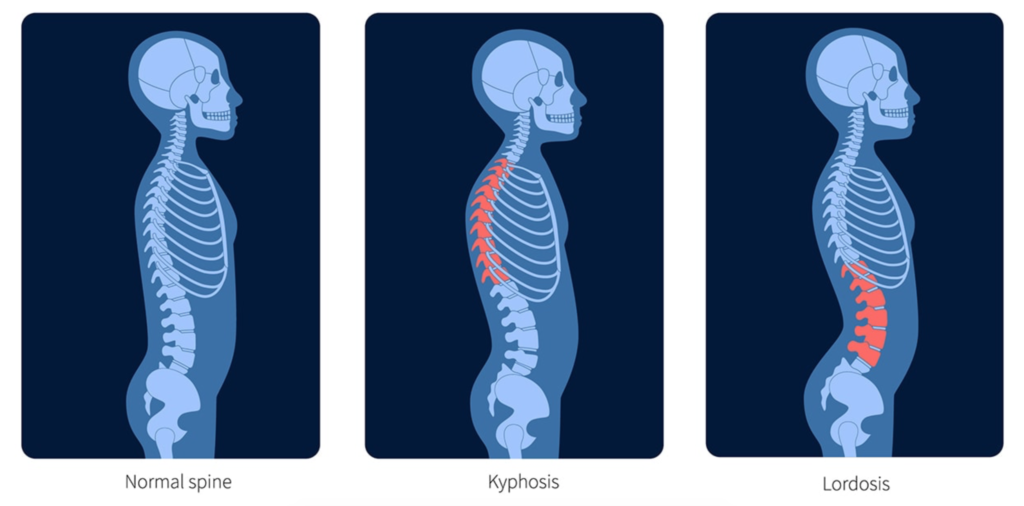LORDOSIS

What’s Lordosis?
The human spine curves a little in the neck, upper back, and lower back to form a characteristic S shape. These curves, also known as the lordotic (neck and lower back) and kyphotic (upper back) curves play a great role in stabilizing and maintaining the structure of the spine. These curves also help the body absorb shock, support the weight of the head, and align the head over the pelvis properly.
The term Lordosis refers to the abnormal inward curvature of the lower spine. Lordosis, also known as swayback, occurs when the inward curve of the spine increases noticeably.
What’s the Causes of Lordosis?
Lordosis affects people of all ages and may occur more commonly among dancers, gymnasts, and individuals with certain conditions. These conditions may include:
Spondylolisthesis
Spondylolisthesis refers to a spinal condition that occurs when a spinal vertebra slips out of the normal position onto the vertebrae below. This condition may develop in individuals that partake in certain sports activities such as gymnastics. Patients with spondylolisthesis may undergo therapy or surgical procedures to treat the condition.
Osteoporosis
Osteoporosis refers to a health condition that causes bones to turn weak and brittle, making these bones more likely to break. This condition leads to decreased bone strength and a significant increase in the risk of bone fractures.
Achondroplasia
Achondroplasia refers to a bone growth disorder that leads to a form of dwarfism.
Other conditions that may cause lordosis include muscular dystrophy, osteosarcoma, obesity, discitis, and some genetic conditions. Tight lower back muscles and rickets may also cause lordosis.
What’s the Symptoms of Lordosis?
Lordosis can lead to excess pressure on the spine, causing pain and discomfort. Muscle pain remains the most common symptom of lordosis. The muscles around the lower spine may tighten and experience limited movement. Other possible symptoms of lordosis may include numbness and tingling, muscle spasms, weakness, weak bladder control, and electric shock pains. These symptoms may also occur in the case of a more severe condition such as a trapped nerve.
How do Spinal Specialists Diagnose Lordosis?
A spinal specialist may request the patient’s medical history and recommend a physical examination to diagnose lordosis. The specialist will likely carry out a physical examination to determine the patient’s range of motion, the flexibility of the curve, and the alignment of the spine. The specialist may also ask questions to narrow down the exact time of appearance of the curve and the areas where the patient feels the most pain.
After this physical examination, the specialist may order tests including MRI and CT scans, and x-rays of the spine to study the angles of the lordotic curve and provide a final diagnosis. The specialist will take into consideration other factors such as height, body mass, and age of the patient before providing the final diagnosis.
How do Spinal Specialists treat Lordosis?
Most times, lordosis treatment involves building strength and flexibility to increase range of motion through physical therapy. Treatment for lordosis largely depends on how severe the lordotic curve of the spine looks and the symptoms that occur. Common treatment options for lordosis include over-the-counter medication to reduce pain and swelling, wearing braces in children, and weight loss to improve posture. Surgical procedures may only occur in cases with severe neurological concerns.
References
Norbert Boos, Max Aebi (2008). Spinal Disorders: Fundamentals of Diagnosis and Treatment. Springer Science & Business Media.
Been, E., & Kalichaman, L. (2014, January). Lumbar lordosis [Abstract]. Official Journal of the North American Spine Society, 14(1), 87-89
thespinejournalonline.com/article/S1529-9430(13)01385-5/abstract
The role of lumbar lordosis, vertebral end-plate inclination, disc height, and facet orientation in degenerative spondylolisthesis. J Spinal Disord. 1999; 12: 68-73
Cho, I. Y., Park, S. Y., Park, J. H., Kim, T. K., Jung, T. W., & Lee, H. M. (2015, October). The effect of standing and different sitting positions on the lumbar lordosis: Radiographic study of 20 healthy volunteers. Asian Spine Journal, 9(5), 762-769
ABOUT LONGHORN BRAIN & SPINE
Founded on Excellence
Founded by Neurosurgeon, Dr. Grant Booher, Longhorn Brain and Spine focuses on a patient-centered approach to alleviating North Texans from Neurological and Spinal Pain. Dr. Booher and his clinical team believe in exhausting all non-invasive protocols first and if needed, employing the least invasive procedures necessary to treat the patients.
Our Beliefs
Dr. Booher believes in a conservative, individualized and holistic approach when it comes to his patients. He prefers exhausting all nonsurgical options and proudly offers the least invasive techniques when clinically indicated. He strives to treat every patient like a member of his family. During his free time, he and his wife enjoy watching sports, listening to Texas country music, and traveling.
